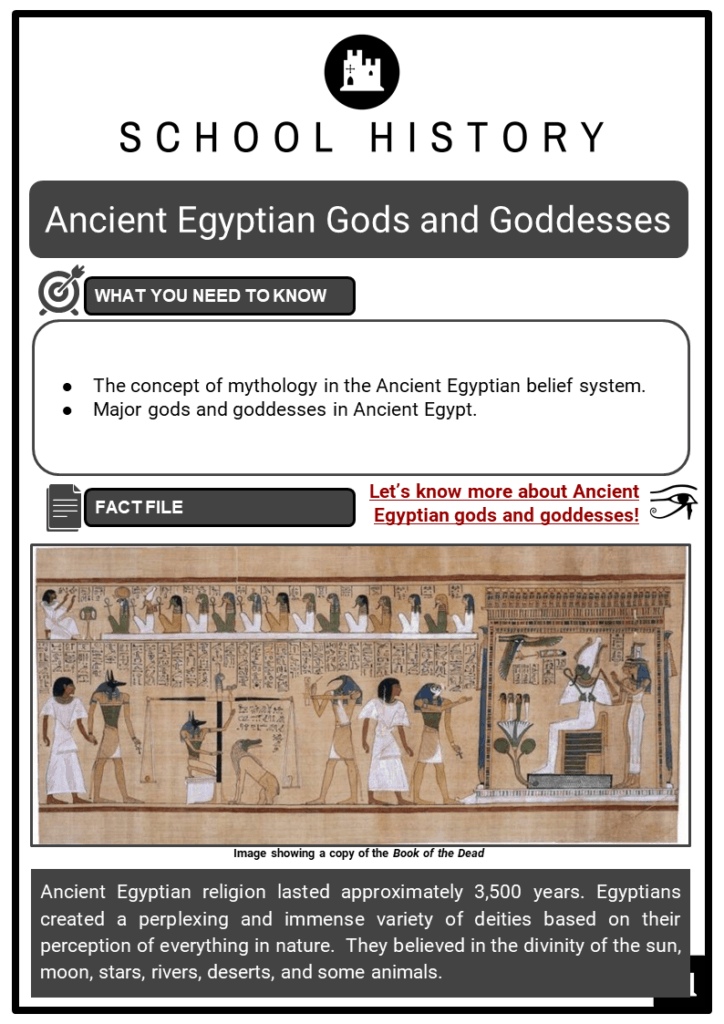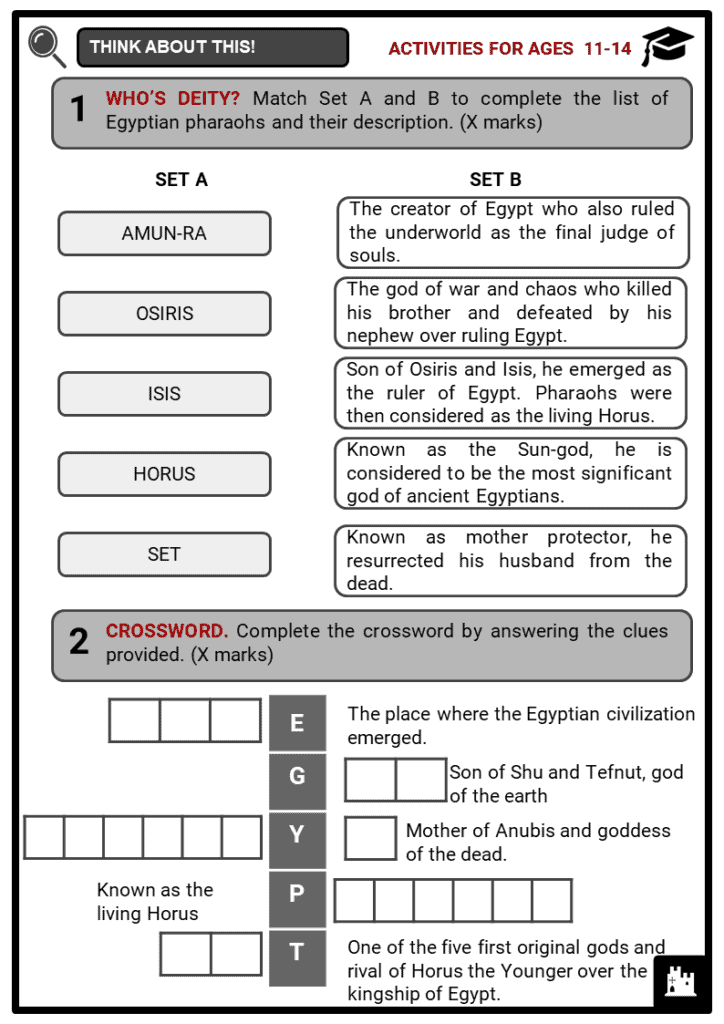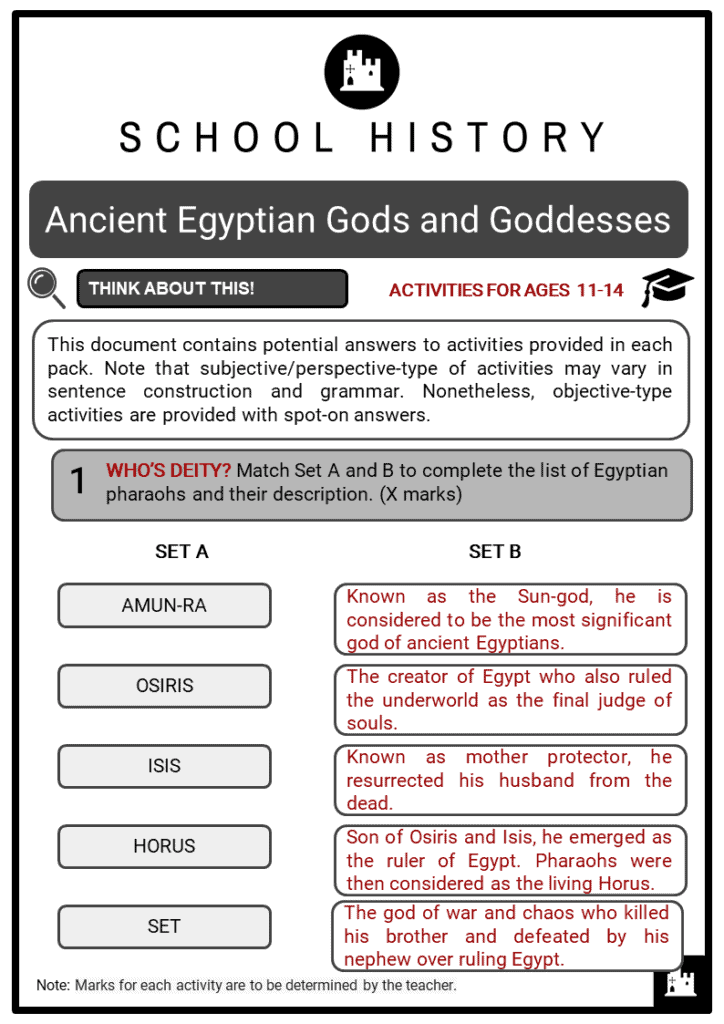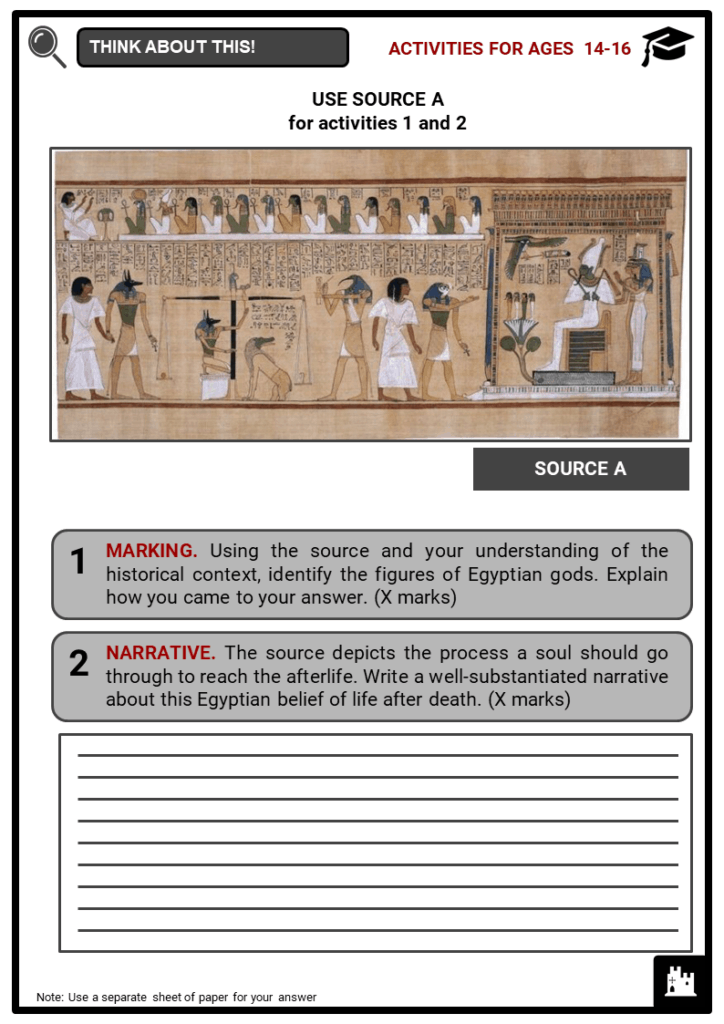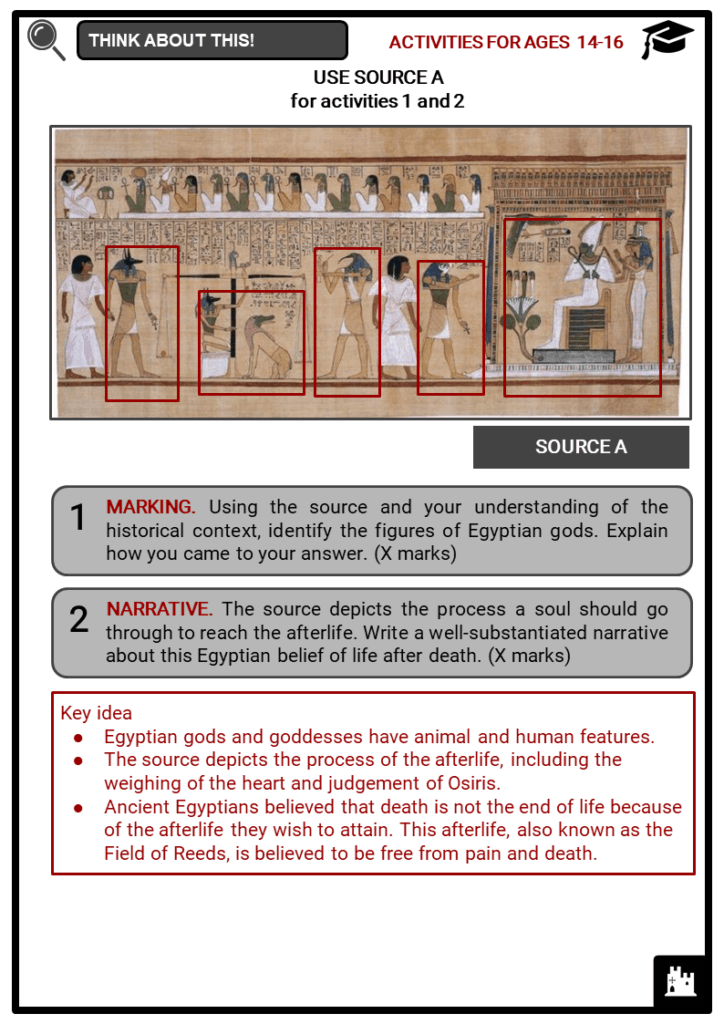Download Ancient Egyptian Gods and Goddesses Worksheets
Do you want to save dozens of hours in time? Get your evenings and weekends back? Be able to teach Ancient Egyptian Gods and Goddesses to your students?
Our worksheet bundle includes a fact file and printable worksheets and student activities. Perfect for both the classroom and homeschooling!
Summary
- The concept of mythology in the Ancient Egyptian belief system.
- Major gods and goddesses in Ancient Egypt.
Key Facts And Information
Let’s know more about Ancient Egyptian gods and goddesses!
- Ancient Egyptian religion lasted approximately 3,500 years. Egyptians created a perplexing and immense variety of deities based on their perception of everything in nature. They believed in the divinity of the sun, moon, stars, rivers, deserts, and some animals.
Concept of mythology and Ancient Egyptian myths
- Myths are conventional stories about heroes, kings and, most often, gods. They usually depict the creation of the world and mostly revolve around stories that describe the relationship between gods and nature, gods and men, and also gods with respect to other gods. They can lay out a moral and social code for men to abide by. In short, myths deal with human beings and supernatural entities.
- In the present day, myths are taken as literary works - they can be analysed and taught through this lens. Due to our scientific rationality, we ignore the actuality of myths and take a great interest in their peculiarity.
- Every mythology has its differences, obscurities, morals, rituals, reasons, and beliefs. Sometimes, they might seem irrational to us. However, they added meaning to human lives in the past and history.
- Amongst the famous myths was the creation of Rome, from Romulus and Remus being suckled by a wolf.
- Gods and goddesses in mythology are more likely to be seen as super-entities, higher form of human beings who use parts of nature to fulfil their purposes.
- Other gods may be merely depicted as the sun, wind or trees. However, most often, gods are shaped in human vessels with recognisable parts, having human emotions, and acting like humans.
- Myths describe gods as immortal human beings: they have some human characteristics, which is why they accept prayers, religious rituals or sacrifices. However, they are never obliged to help human beings, only if they desire to.
- Similar to other ancient societies, early Egyptian culture specifically, religion was filled with mythology.
- For over 3,5000, Ancient Egyptians created hundreds of gods in their mythology. Some gods had animalistic forms, while others had human features mixed with animalistic ones. Their gods often had more than one name, and more than one shape.
The Story of Creation
- For the early Egyptians, the universe was created out of darkness. It is believed that the god Atum saw this nothingness and used magic and his own shadow to give birth. The union created Shu (god of air) and Tefnut (goddess of moisture). His two children set out and established the world. While they were away, Atum felt lonely and sent his eye to search for his children. When Shu and Tefnut returned, their father shed tears of joy, which created men and women.
- Ancient Egyptians believed that gods and goddesses possessed heka or magical power that enabled them to sustain all life.
- According to mythology, Osiris was killed by his brother Set and was resurrected by his wife/sister Isis.
- When Osiris came back to life, he descended to the underworld to be the final judge of the dead as they travel to the afterlife.
- They believed that when the soul left the physical body at death, it travelled to and appeared in the Hall of Truth to stand before Osiris.
- The Field of Reeds was the final destination of souls who passed the golden scale and test of the feather of Ma’at.
Rivalry of Horus the Younger and Set
- Out of jealousy, Set tricked his brother Osiris to death using a coffin. Set dismembered the body of his brother and threw it all over Egypt. When Osiris’ son, Horus the Younger, came of age, he challenged his uncle over the throne of Egypt.
- Horus the Younger presented himself to a tribunal composed of the Sun god Ra, god of wisdom Thoth, and Shu, the god of air.
- To test who was the rightful king of Egypt, Horus and Set were given tests.
- Both turned into hippopotami and sat on the bottom of the Nile River. The last to come up for air won.
- Another test was a race of stone ships down the Nile. Horus won this test after deceiving his rival by using a boat made of pine covered with gypsum.
- The final verdict was given by Osiris and favoured his son, Horus to be the King of Egypt. On the other hand, Set was made a prisoner.
The feather of Ma’at
The goddess of truth and morality, Ma’at was a daughter of Ra. Her Feather of Truth is said to be weighed against the hearts of the dead to determine whether the dead deserved to cross into the afterlife.
Using a golden scale, a deceased heart was placed on the one end of the scale against the feather of Ma’at. If the heart was heavier than the feather, the person would not be permitted into the Field of Reeds; instead the deceased would die again.
Major gods and goddesses of Ancient Egypt
AMUN- RA
- Amun Ra was the great god of the sun, and one of the most important deities in Egyptian religion. He was also the creator god; of the world as well as the underworld. He was the god of the sun, god over all kings, and a god who controlled the world’s order. The myth describes that humans were created by Ra’s tears and sweat. As such, Egyptians called themselves the “cattle of Ra”.
- Ra rose from the ocean and created himself from chaos, and then created all forms of human life. Heliopolis (a major ancient Egyptian city) was the centre of his worship.
- He has a golden disk above his head when depicted in a human form. There is also a serpent around the golden disk, giving the image of a crown.
- Ancient Egyptians saw divinity in the sun, as it has many important qualities. Ra, the sun god, represented warmth, growth, nature, light, and life. In effect, Ra was regarded as a principal god and giver of life.
OSIRIS
- Osiris was the first son of Geb and Net and was regarded as the creator of Egypt and god of the dead. He was portrayed with green skin, like his father.
- When Ra left the world to rule the heavens, Osiris ruled the world of men after him. However, Osiris was murdered and cut into pieces by his brother Set.
- In Ancient Egypt, when pharaohs died, they were associated with Osiris, being wrapped as mummies, as Isis did for Osiris. They thought that with wrapping the pharaoh, he would eventually be reborn.
ISIS
- Isis was the goddess of magic, fertility, and motherhood. The first daughter of Geb and Nut, she is portrayed as a woman wearing a long sheath dress. She has a solar disk and horns on her head. In rare instances, she has the head of a cow. Known for protecting women and children, and healing the sick, Isis brought her brother/husband, Osiris back to life.
SET
- Also known as Setesh, Sutekh, Sheth, and Setan, Set is the god of chaos, storms, envy, trickery, fire, and the desert. He is known for killing his brother Osiris for power and later his nephew, Horus the Younger as ruler of Egypt.
- Set resembled no known creature; his figure was combined in an aardvark, a donkey, a jackal, or a fennec fox. He had rectangular ears, a disfigured snout, a tail, and canine body. In later times, Egyptians depicted him as a man with a donkey’s head.
NEPHTYS
- Nephtys, the goddess of mourning, rivers, the night, service, childbirth, and home, is often paired with her sister Isis. In art, she is drawn with a long dress and a basket on top of the glyph. In mythology, she helped Isis bring Osiris back to life, so she is usually depicted in tombs as a protector of the dead.
- Horus the Younger
- Horus the Younger is the son of Osiris and Isis, conceived through magic. He is often depicted as a human with a falcon’s head and represents rebirth. The elder Horus is the sky god, brother of Osiris and Isis, and the last of the first five original gods. Horus the Younger is known for avenging his father’s death and defeating Set, his uncle, over the rule of Egypt.
- In ancient Egypt, pharaohs were often regarded as the living Horus. He is known as the protector of the royalty of Egypt.
ANUBIS
- Also known as the Jackal god, Anubis is associated with the process of mummification and the afterlife. Since the 1st Dynasty, Anubis was known as a protector of graves. He is often depicted with a black jackal’s head. Despite being one of the most popular Egyptian gods, there was no temple built for him, at least according to archaeological finds today.
- In addition to the deity of embalming, Anubis is also regarded as the guardian of the scales during the weighing of the heart.
- Other significant deities included: Hathor, the cow goddess of feminine love and motherhood. In the early times, she was associated with the flooding of the Nile, making it fertile in the process. During the pre-dynastic era, Hathor was regarded as the mother of Amun-Ra.
- Bastet/Sekhmet, the feline goddess of love and war. Depicted with a cat-like head and a woman’s body, Bastet was worshipped from the 2nd Dynasty. With great reverence of cats as a symbol of Bastet, Ancient Egyptians used to mummify them for use in ceremonies.
- Worshipped from the pre-dynastic period until the Greco-Roman Era, Thoth, the Ibis god of wisdom, is depicted as a man with the head of an ibis. He is the husband of Ma’at, goddess of truth and justice.
- Sobek is the deity of the Nile and is represented as a man with the head of a crocodile, sometimes adorned with a crown. Interestingly, mummified crocodiles have also been found by archaeologists, which proves the god’s popularity.
- Bes, the guardian of childbirth, is depicted as a grotesque dwarf with his tongue out.
- In order to honour and please the gods, pharaohs built large temples adorned with statues, memorials, and places of worship. Some known temples include the Temple of Isis at Philae, the Temple of Horus at Edfu, and the Temple of Amun at Karnak.

